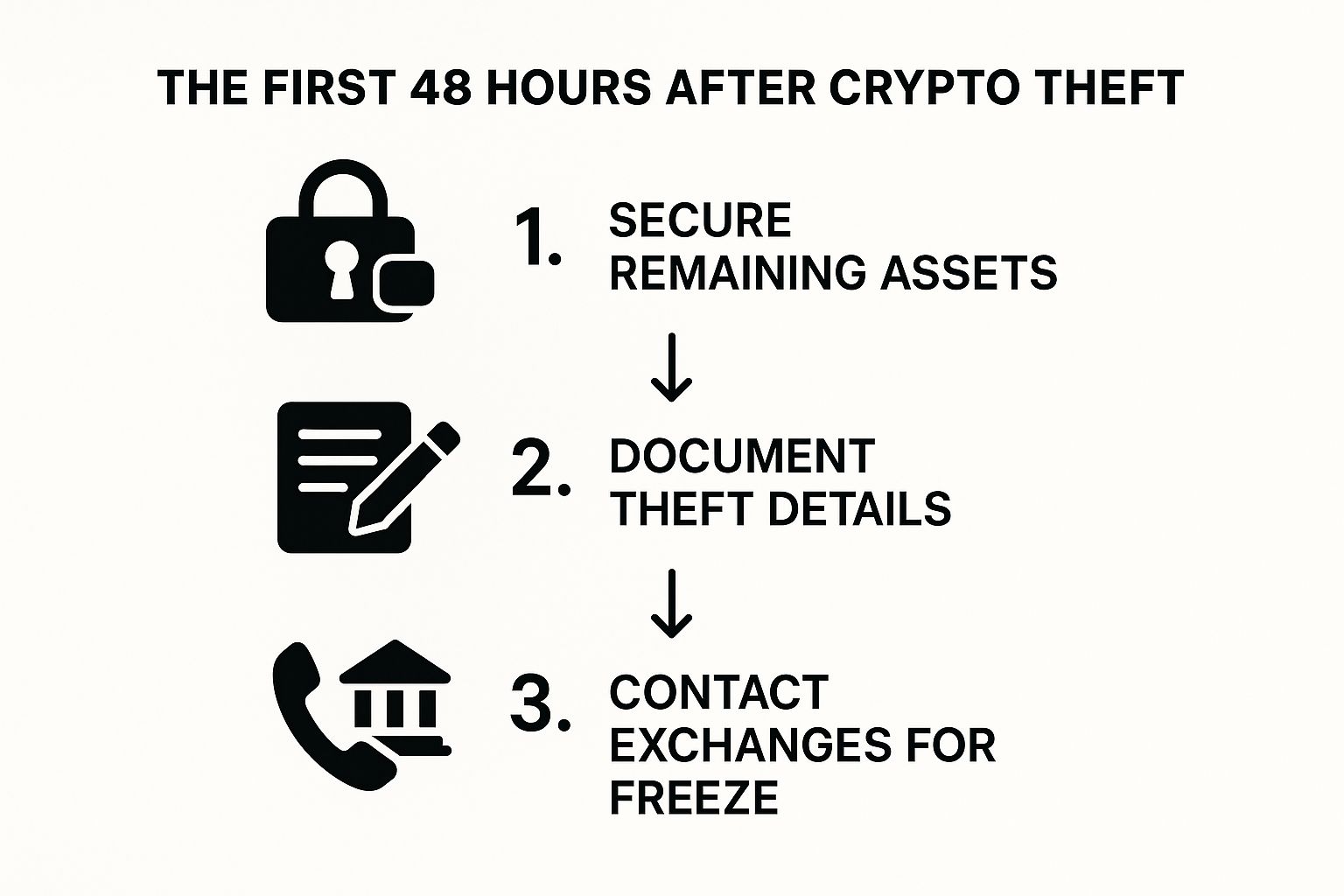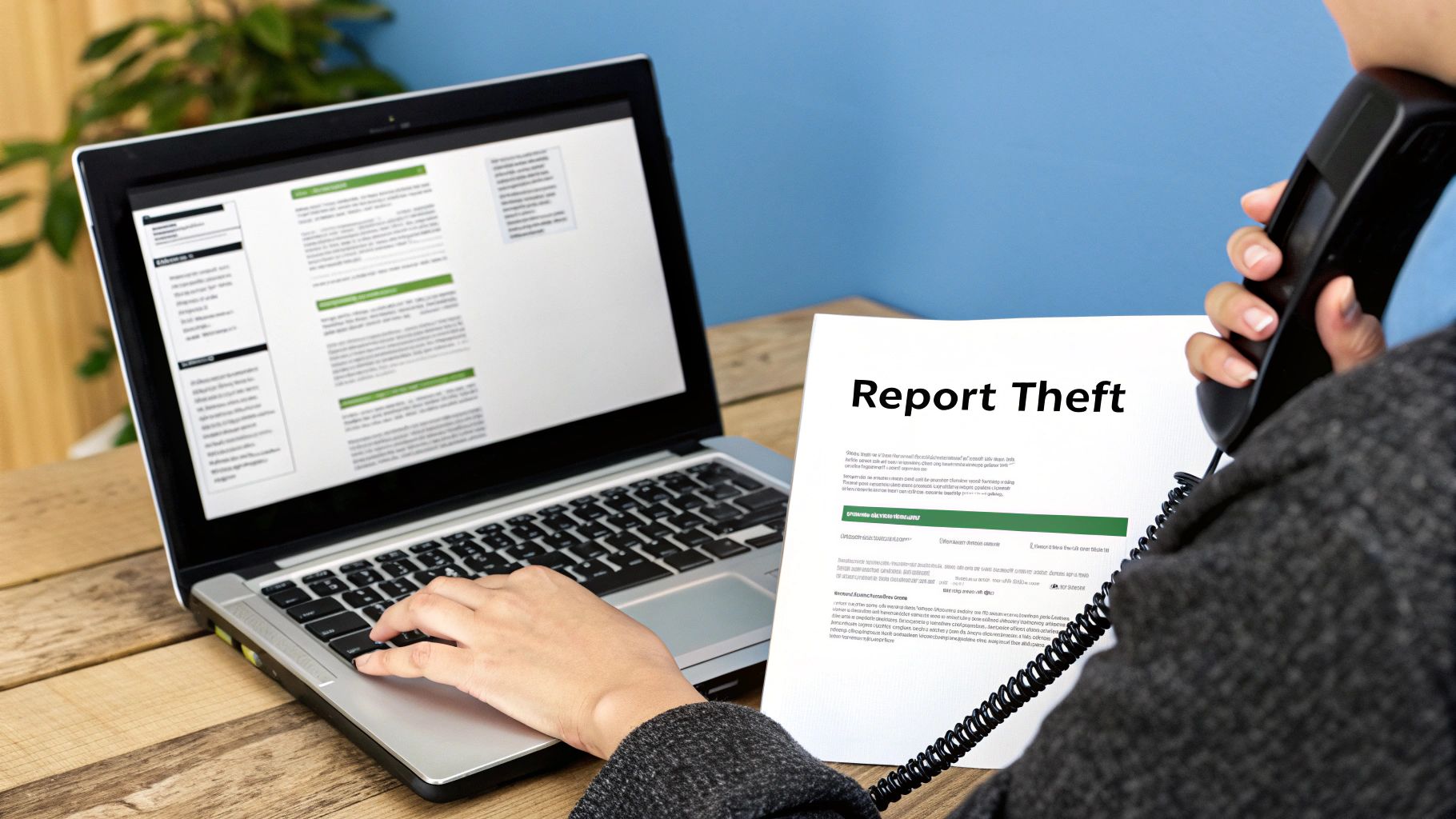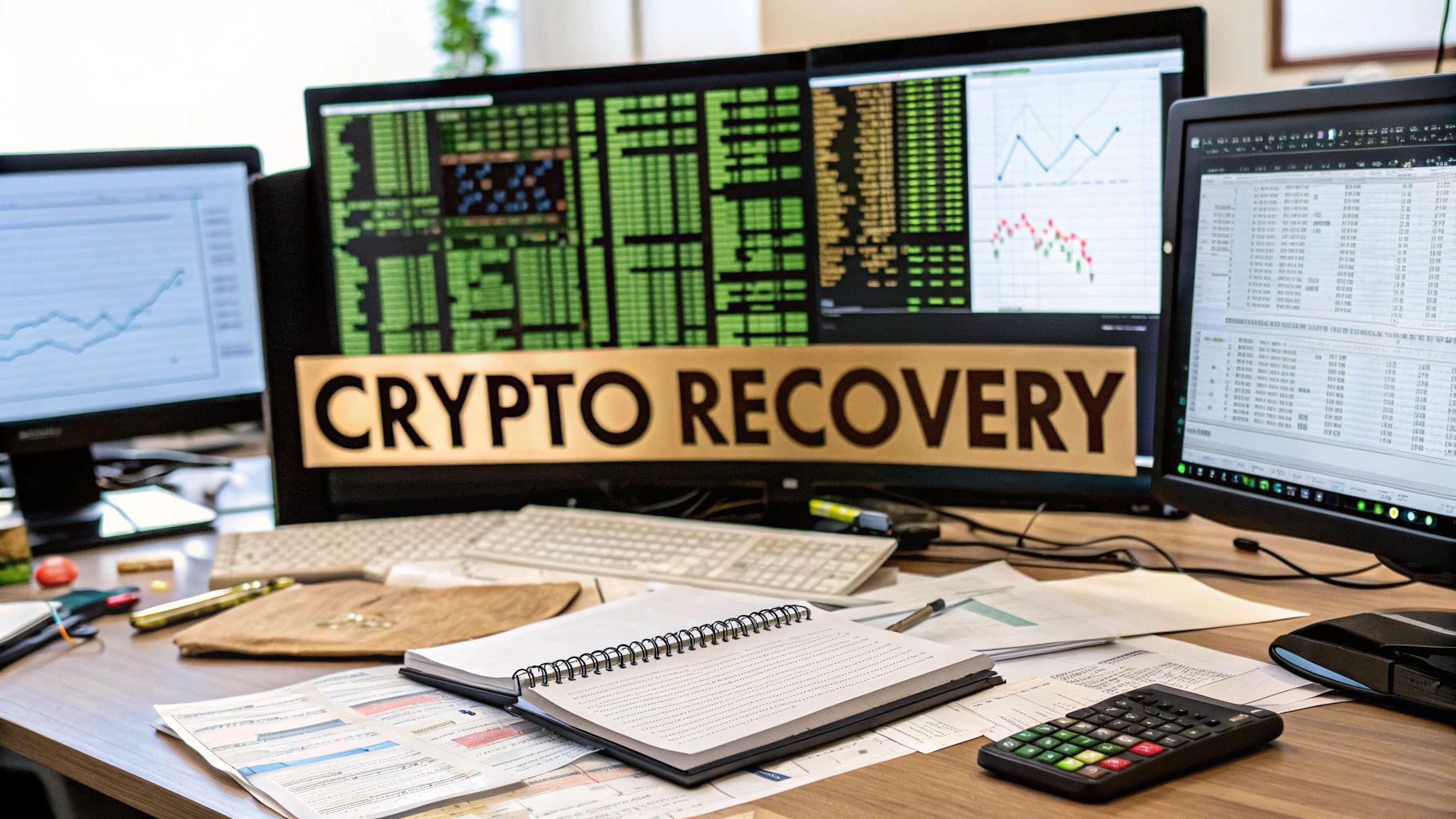When you realize your crypto has been stolen, your stomach drops. It's a feeling of pure panic. But what you do in the next 48 hours is absolutely pivotal—it can mean the difference between getting your funds back and losing them forever.
The first few moments are a frantic race against time. The thieves are already working to launder your assets, and every minute that passes makes their trail harder to follow. Your job is to act fast, stay calm, and immediately start building the case to get your money back.
Your First 48 Hours After a Crypto Theft
Let's be clear: the digital trail left by crypto transactions is permanent, but it gets buried quickly. Scammers use mixers, chain-hopping, and a dozen other tricks to make the funds disappear into the digital ether. Your goal is to move with precision to preserve every shred of evidence and stop them cold.
This isn't just about damage control. It's about immediately shifting your mindset from victim to investigator. Every screenshot, every transaction ID, every account you secure—it all builds the foundation for a successful recovery.
Lock Down Your Digital Life Immediately
First things first: contain the breach. Assume the attacker is still in your system.
Before you even think about reporting it, you need to move any remaining funds you have on compromised exchanges or wallets. Get them out. Transfer them to a brand-new, secure wallet that you've just created on a device you know is clean.
Next, it's time for a password overhaul. Change the passwords on everything, starting with your primary email. If a scammer has your email, they have the keys to your entire digital kingdom. Turn on two-factor authentication (2FA) for every single account, and make sure you're using an authenticator app, not the less-secure SMS codes.
This visual guide breaks down the most critical actions to take right after you discover a theft.

As the chart shows, securing your remaining assets is the absolute first priority. From there, it's all about gathering evidence and getting the right people involved as quickly as possible.
Immediate Actions After Discovering Crypto Fraud
Taking swift, organized action is your best defense. The table below outlines the most critical steps to prioritize immediately after a crypto theft to secure what's left and maximize your recovery chances.
| Action Item | Why It Is Critical | Timeframe |
|---|---|---|
| Move Remaining Funds | Prevents further losses if the hacker still has access. Containment is priority one. | Immediately |
| Change All Passwords | Locks the attacker out of your email and other financial accounts. | Within 15 Mins |
| Enable App-Based 2FA | Adds a crucial layer of security that SMS codes can't match. | Within 30 Mins |
| Screenshot Everything | Preserves evidence of scam websites, messages, and transaction details before they disappear. | Within 1 Hour |
| Compile Transaction IDs | This is the digital "receipt" that proves the theft and is essential for tracing funds. | Within 1 Hour |
| Notify Exchanges | If funds went to a known exchange, they may be able to freeze the scammer's account. | Within 2 Hours |
Following these steps methodically will put you in the best possible position for the next phase of the recovery process.
Document Everything Meticulously
Your memory of the event will get fuzzy under stress, but digital records don't lie. You need to start building a detailed timeline of what happened, right now.
Start grabbing screenshots of everything connected to the theft: the fake website, the sketchy email or text that started it all, the scammer's social media profile, and especially the transaction history from your wallet showing the unauthorized withdrawal.
Key Takeaway: Treat this like a crime scene. Every tiny detail matters. It could be the one piece of evidence that cracks the case. Make a note of the exact date and time you found out, and the last time you can confirm your funds were safe.
You absolutely must gather these details:
- Transaction IDs (TxIDs): This is the long string of letters and numbers that identifies the transaction on the blockchain. It's the most important piece of evidence you have.
- Scammer's Wallet Address: The address your crypto was sent to.
- Your Wallet Address: The address the funds were stolen from.
- Exact Amounts and Types of Crypto Stolen: Be precise. Write down 1.5 BTC, 20.3 ETH, or whatever it was.
Contact Exchanges and Consider Professional Help
If you can see that your stolen crypto landed in a wallet at a major centralized exchange like Coinbase or Binance, contact their fraud department immediately. Give them the transaction ID and the scammer’s wallet address. There are no guarantees, but they can sometimes freeze accounts tied to criminal activity, which stops the thief from moving your funds any further. For a more complete overview of the process, you can learn more about how to recover lost cryptocurrency in our dedicated guide.
This 48-hour window is also when bringing in a professional can have the biggest impact. Crypto recovery is a specialized field, and the top firms have tools and contacts you simply don't. For instance, firms like Puran Crypto Recovery (PCR) have reported a staggering 94% success rate across more than 4,000 cases in 2024 alone. They achieve this by using advanced forensic tools and hitting the ground running—something that’s only possible when victims act fast.
Gathering the Digital Evidence for Your Case

Once you've secured your remaining assets, it's time to shift gears and become a digital detective. A successful recovery hinges entirely on the quality of the evidence you can pull together. Every little bit of information acts as a breadcrumb, helping investigators, law enforcement, and recovery specialists trace the path of your stolen funds.
Think of it this way: the blockchain itself is just a public ledger of transactions. What gives it context is the story around those transactions—the emails, the Telegram chats, the fake websites, the promises the scammer made. Your job is to meticulously collect and preserve that entire narrative.
This isn't just about dragging files into a folder. You're building a clear, chronological case file that leaves no room for doubt. It's the most powerful tool you have.
The Blockchain Paper Trail
The heart of your evidence lies on the blockchain. This data is permanent and provides undeniable proof of where your crypto went. It’s the digital equivalent of a bank wire record, and you can’t proceed without it.
You’ll want to start by gathering these key details for every single fraudulent transaction:
- Transaction Hash (TxID): This is the unique receipt for the transaction. It's the single most important piece of evidence you can have.
- Scammer’s Wallet Address(es): The destination addresses where they sent your crypto. Scammers often hop between wallets, so document every single one.
- Your Wallet Address(es): The addresses the funds were stolen from.
- Timestamps: The exact date and time of each transfer, which you can find on any block explorer.
- Precise Amounts: Note the exact amount and type of crypto stolen (e.g., 1.35 BTC, 25.7 ETH).
A quick tip from experience: Don't just copy and paste this stuff into a text file. Take high-resolution screenshots of the transaction details on a block explorer like Etherscan or Blockchain.com. Visuals add a powerful layer of verifiable proof.
Capturing the Scammer’s Footprints
Beyond the on-chain data, you need to save every shred of your interaction with the scammer. They are masters at covering their tracks, so you have to move quickly before they delete accounts and take down websites.
Set up a secure folder on your computer and start saving everything. I mean everything.
- Communications: Screenshot every single message. Whether it was on Telegram, WhatsApp, email, or social media DMs, capture it. Don't crop the images—make sure you get the timestamps and the sender's info.
- Fraudulent Platforms: Take full-page screenshots of the fake investment site, phishing page, or malicious app. A crucial detail is to make sure the website's URL is visible in the address bar.
- Scammer Profiles: Save any social media profiles, usernames, or contact details you have for the scammer. Even if they're fake, these can provide investigators with valuable leads.
- Initial Contact: Make a note of how they first got in touch. Was it a random email? A social media ad? A message in a Discord group? This helps establish their methods.
Building a Coherent Timeline
Now that you have all the puzzle pieces, the final step is to put them in order. A simple document or spreadsheet is perfect for this. Lay out the events chronologically, from the very first contact to the moment you realized you'd been scammed.
For instance, your timeline might look something like this:
- June 5, 10:15 AM: Received a DM on Twitter from user "@CryptoGuru123" about a new investment platform. (Attach screenshot of the message).
- June 5, 2:30 PM: Visited their website,
secure-invest-crypto.net. (Attach a full-page screenshot of the site). - June 6, 9:00 AM: Transferred 0.5 BTC from my wallet (
bc1...) to their deposit address (3J9...). Transaction ID:[...TxID...]. (Attach screenshot from the block explorer). - June 10, 4:00 PM: Tried to log in to the website but it was down. Realized my funds were gone.
This level of organization does more than just help you make sense of what happened. It hands law enforcement and recovery firms a ready-made case file, saving them critical time and showing them you're a serious, credible victim. This preparation can make a real difference in the outcome.
How to Navigate Official Reporting Channels

After the initial gut punch of a crypto theft, the thought of wading through bureaucracy can feel completely overwhelming. It’s easy to wonder, "Will they even get it?" or "Is this just a waste of time?"
I can tell you from experience: it's not. Filing official reports is an absolutely critical step in any legitimate crypto fraud recovery effort.
These reports aren't just about creating a paper trail for your own case. They feed into massive national and international databases that law enforcement uses to track criminal networks. Your case might feel isolated, but when it’s combined with hundreds of others, it helps investigators connect the dots, build major cases, and ultimately bring the heat on exchanges to cooperate.
Think of your report as one crucial piece of a giant puzzle. It simply can't be solved without you.
Knowing Who to Contact
First things first, you need to get your report in front of the right people. In the United States, several agencies handle cybercrime, and it's best to file with all of them since they have different jurisdictions and specialties.
- The FBI's Internet Crime Complaint Center (IC3): This is your starting point. The IC3 is the main intake hub for cybercrime reports in the U.S. From there, your complaint gets analyzed and sent to the right FBI field office or law enforcement partner.
- The Federal Trade Commission (FTC): The FTC comes at it from a consumer protection angle. They collect data on scams and fraudulent business practices to spot trends and enforce consumer laws.
- The Commodity Futures Trading Commission (CFTC): If the scam involved a crypto derivatives or commodities trading platform, you'll want to loop in the CFTC. They have specific oversight for fraud in these markets.
Don't forget your local police department. They might not be blockchain wizards, but a local police report is often a non-negotiable requirement for any insurance claims or banking disputes tied to the fraud.
How to File a Report That Actually Gets Noticed
Just scribbling down "I was scammed" isn't going to move the needle. The detail and clarity of your report can make all the difference in whether it gets attention or sits in a digital pile. You've got to present the evidence you gathered in a way that's impossible to ignore.
When you're filling out the online forms for agencies like the IC3, have your detailed timeline and all your evidence ready to go.
Expert Tip: Tell a clear story. Start from the very beginning—how the scammer first contacted you. Walk them through their methods, detail every single transaction, and explain the "aha" moment when you realized it was a fraud. The easier your story is to follow, the easier it is for an agent to take action.
Your goal is to make an investigator's job as simple as possible. A well-structured report, packed with all the necessary digital proof, is far more likely to get escalated than a vague one.
The Power of Collective Action
It’s important to be realistic here. Law enforcement agencies are buried in reports and tend to prioritize massive cases involving millions of dollars. While they might not be able to chase down every individual theft, your report is never wasted.
Here’s a real-world scenario: The FBI might notice dozens of different reports all pointing to the same fraudulent website or a similar cluster of scammer wallet addresses. That collective data is what triggers a major investigation, leading to seizures and arrests that dismantle the entire criminal operation.
The sheer scale of crypto crime makes these reports more important than ever. In just the first half of 2025, investors lost an estimated $3.1 billion to crypto scams and hacks, with yearly losses projected to top $4.3 billion. The good news? The average recovery rate is slowly climbing, largely thanks to victims, law enforcement, and blockchain analytics firms working together. You can read the full research about these crypto scam statistics to see the bigger picture.
Your report feeds directly into these larger enforcement wins. It provides the data points needed to connect dots, identify criminal infrastructure, and build the kind of airtight legal cases that lead to real asset seizures. When you file, you're not just fighting for yourself—you’re helping shield the entire crypto community from these predators.
Filing a report with the FBI or local police is a crucial first step, but let's be realistic—it's just the beginning. Law enforcement agencies are often buried under massive caseloads, focusing on building long-term cases against international criminal syndicates. That can take years.
While you're waiting, your stolen crypto is on the move, being laundered through mixers and swapped across chains. This is where a professional crypto fraud recovery service becomes a game-changer.
These specialists aren't trying to put a cartel behind bars; their only mission is to get your money back. They operate on a much faster timeline, using their specific expertise to follow your transaction trail. It's a targeted, aggressive approach that can dramatically improve your odds of seeing those funds again.

What Legitimate Recovery Experts Actually Do
A real crypto recovery firm is a team of digital forensic investigators, not just people sending sternly worded emails. They live and breathe the blockchain, blending deep technical skills with sharp legal strategy.
Here’s a look at what’s happening behind the scenes:
- Advanced Blockchain Analysis: They deploy sophisticated software to visually map where your funds went. They can unravel tangled transaction chains, peel back the layers of privacy mixers, and trace your assets even when they jump from one blockchain to another.
- Exchange and Legal Coordination: Legitimate services have working relationships with the compliance teams at major crypto exchanges. They know how to package evidence in a way that gets a scammer’s account frozen quickly and efficiently.
- Global Collaboration: Crypto crime doesn't respect borders. Top-tier recovery firms have a network of international legal partners ready to take action in different jurisdictions to seize assets when necessary.
They essentially act as the bridge between the raw data on the blockchain and the real-world legal and financial systems needed to claw back your assets.
The blockchain is a public ledger, sure, but trying to read it without expertise is like trying to decipher an ancient language in the dark. Recovery specialists are the translators who can read the code and follow the money.
Vetting a Service and Avoiding Recovery Scams
Tragically, where there are victims, there are predators. The desperation to recover lost funds has given rise to a nasty second wave of "recovery scams." These cons promise to help but are only interested in taking what little you have left.
Learning to spot the fakes is non-negotiable. A genuine service operates with transparency and professionalism. If you need a benchmark for what that looks like, check out the process outlined by a professional recovery service to see how a trustworthy engagement should work.
Keep your guard up and watch for these massive red flags:
- Guarantees of Success: Nobody can promise 100% recovery. The process is far too complex. Anyone offering an ironclad guarantee is lying to you.
- Large Upfront Fees: Reputable firms almost always work on a contingency basis, often called "no-win, no-fee." Their payment is a percentage of the funds they successfully recover for you. Demands for big payments upfront are a classic scam tactic.
- Requests for Private Keys or Wallet Access: This is the biggest red flag of all. A real investigator will never ask for your seed phrase, private keys, or any other credentials. They only need public, on-chain data to do their job.
Comparing Crypto Recovery Approaches
Deciding on the best path forward really depends on your specific situation. Not every approach is right for every case.
The table below breaks down the main options for crypto fraud recovery, giving you a clear look at the pros and cons of each.
Comparing Crypto Recovery Approaches
| Recovery Method | Pros | Cons | Best For |
|---|---|---|---|
| Law Enforcement | Free, with legal authority to seize assets and make arrests. | A very slow process; your case may not be a priority, and recovery isn't the main goal. | All victims. It's an essential first step for documentation and creating a legal record. |
| Professional Service | Fast and focused, with specialized expertise and high-tech tools. | Costs a percentage of recovered funds; requires careful vetting to avoid scams. | Complex cases with significant losses, especially those involving mixers or international transfers. |
| Self-Recovery | No cost, and you maintain complete control over the process. | Extremely difficult without specialized tools and deep knowledge; very low success rate. | Very simple cases where funds were sent directly to an exchange wallet with a clear trail. |
In the end, hiring a professional service is a strategic move. It's for victims who have lost a significant amount and realize that a specialized, aggressive approach is often the only way to navigate the murky world of illicit crypto transactions and get a real result.
To get your crypto back, you first have to understand the world it just entered. It's a shadowy, complex ecosystem designed from the ground up to make stolen funds disappear.
Stolen crypto doesn't just land in a new wallet and sit there. The second it's gone, it’s already moving through a high-speed laundry cycle. The entire goal is to break the on-chain link between the crime and the criminal’s wallet, making the trail impossible for most people to follow.
The Criminal's Playbook for Hiding Funds
The techniques they use are sophisticated, but they aren't magic. Knowing what you're up against is crucial because it highlights the exact strategies professionals use to corner them.
- Crypto Mixers (or Tumblers): Imagine a digital black box. Scammers pool your stolen funds with thousands of other transactions. The mixer jumbles everything together and sends out "clean" coins to new addresses, completely severing the direct link to the theft.
- Chain-Hopping: This is where they jump between blockchains, maybe from Ethereum over to Solana, using a cross-chain bridge. Every hop is another layer of complexity, another tangled thread for investigators to pull.
- Privacy Coins: Sometimes, they’ll swap traceable coins like Bitcoin for something like Monero. These privacy coins are built to hide sender and receiver data by default, which can be a dead end for amateur sleuths.
They're using the decentralized nature of crypto—the very thing that makes it so appealing—as a shield.
But here's the beautiful irony: the blockchain's greatest strength, its permanent public ledger, is also the criminal's greatest weakness. They can obscure the trail, but they can never erase it. Every move leaves a digital footprint that can’t be washed away.
A Surprisingly Small Underworld
While the methods are complex, the network of criminals running the show is smaller than you'd think. A handful of illicit services and dirty wallets handle the vast majority of all stolen funds. This concentration actually creates a massive target.
This is where recovery becomes possible. Investigators don't have to chase down every last fraction of a coin. Instead, they look for the moment your funds touch a known bad actor—a shady exchange, a notorious mixer—and that’s where they can apply legal pressure.
Blockchain analytics firms have gotten incredibly good at mapping out this criminal infrastructure. According to one report, in 2025, illicit entities will directly control almost $15 billion in crypto. But the ripple effect is even bigger. Wallets that have received a significant amount of their balance from these criminal sources hold over $60 billion. You can discover more insights on the landscape of seizable crypto assets from Chainalysis to see just how deep this runs.
This all points to one critical truth: to actually spend the money, criminals have to touch the real world at some point. That interaction is their point of failure. It's the exact moment a skilled investigator can use the blockchain's transparency to turn the tables.
Burning Questions About Crypto Fraud Recovery
When you get hit by a crypto scam, the shock and panic are quickly followed by a tidal wave of questions. The path forward feels foggy at best, and it's natural to feel completely lost. Let's cut through that noise and tackle the most common questions we hear from victims.
The hard truth is that while the blockchain is permanent, the crooks who use it are masters of disguise. Knowing what's realistic and what's not is the first step toward getting your assets back.
Is It Really Possible to Recover Stolen Crypto?
Yes, it’s absolutely possible—but it’s never a sure thing. Anyone who tells you otherwise isn't being straight with you. Success really boils down to a few critical things: how fast you act, the type of scam you fell for, and where the funds ended up.
Think about it: crypto that lands in a wallet at a big, regulated exchange is much easier to freeze and claw back. Those exchanges have compliance teams that actually work with law enforcement. On the flip side, if your funds were tumbled through a decentralized mixer or swapped for a privacy coin like Monero, the challenge gets a lot steeper. It's tough, but even in those cases, professionals and law enforcement have managed to recover millions for victims.
Key Takeaway: Be immediately suspicious of anyone promising a 100% success rate. Blockchain tracing and international law are far too complex for those kinds of guarantees. A real expert will be upfront about the challenges.
How Can I Spot a Recovery Scam?
It’s a cruel twist, but scammers love to prey on victims a second time by posing as recovery experts. They feed on your desperation, so learning to spot their tricks is crucial to avoid losing even more.
The number one red flag? A demand for a large upfront fee. They'll call it a tax, a network fee, a legal retainer, or some nonsense about "wallet synchronization." Don’t fall for it. Reputable services almost always work on a contingency basis—they only get paid if you get paid.
Keep an eye out for these other warning signs:
- They Found You: Someone slid into your DMs on social media or emailed you out of the blue, saying they saw your story and can help? Big red flag.
- They Ask for Your Keys: Never, ever give anyone your private keys or seed phrase. A legitimate service will never need direct access to your wallet.
- They're Vague on the "How": If they can't clearly explain their process without hiding behind a wall of confusing tech jargon, you should walk away.
What Does a Legitimate Recovery Service Actually Cost?
The best firms operate on a "no-win, no-fee" model. This is what you want to see, because it means their goals are perfectly aligned with yours. They only make money if they succeed.
Typically, their fee is a percentage of the crypto they manage to recover for you. You can expect this to be anywhere from 10% to 30%, depending on how messy the case is. A complex trace that crosses multiple blockchains and involves different countries will naturally be on the higher end of that scale.
Some firms might ask for a small, reasonable fee to open your case file or for an initial consultation, but that should be laid out clearly. Always get a written contract detailing the entire fee structure before you sign anything.
How Long Does This Whole Recovery Process Take?
This is the hard part: you have to be patient. There’s no standard timeline, and the process can vary wildly from one situation to the next.
In a best-case scenario—where the stolen funds are traced quickly to a cooperative, centralized exchange—you might see a resolution in a few weeks or months.
But most cases aren't that simple. If the recovery requires untangling a complex web of transactions through mixers, dealing with multiple legal systems, and filing formal legal actions, the process can easily stretch to a year or more. The investigation is painstaking work, and the legal system moves at its own pace. A slow and steady approach is often the only way to win.
If you've lost access to your wallet or been the victim of a scam, the team at Wallet Recovery AI can help. Our AI-enhanced approach and team of experts are dedicated to helping you regain control of your digital assets securely and discreetly. Contact us today for a confidential consultation.


Leave a Reply